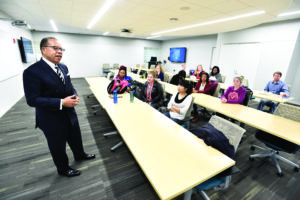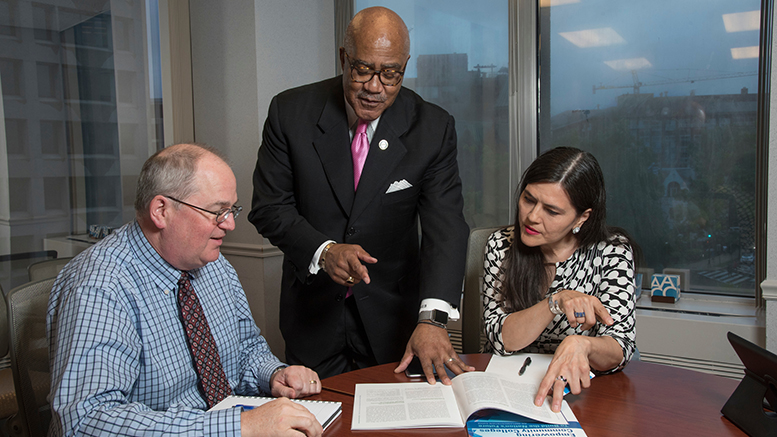In 2012, the American Association of Community Colleges (AACC) released a report stating, in no uncertain terms, that “the American dream is imperiled.” Data supporting this declaration highlighted a sagging economy and a record number of Americans who had fallen into poverty.
A product of the 21st-Century Commission on the Future of Community Colleges, the report “Reclaiming the American Dream: Community Colleges and the Nation’s Future,” outlined the challenges facing the country, citing two-year colleges as potential beacons guiding the U.S. back to global competiveness and prosperity.
Five years later, many of the nation’s community colleges have taken the report’s lofty ambitions to heart, says AACC President and CEO Walter Bumphus. Policy ideas laid out by the document have broken down barriers inhibiting students, propped up degree and certification completion rates, and narrowed attainment gaps across groups of learners.
“We have a framework of accountability with strategies that came out of it,” Bumphus says.
The report was, for the most part, positively received, according to Kay McClenney, who served as co-chair of the 21st-Century Commission.
“Responses from both within and beyond the community college field included accolades for, first, taking a clear-eyed look at the challenges ahead for American society; second, delineating the important roles for community colleges in rising to those challenges; and finally, setting forth an agenda for the transformational work that is requisite for our institutions to do what America needs from us,” McClenney says.
“At the institutional level, leaders often took a deep breath, observed the magnitude of the problems we need to solve, and then, in true community college fashion, rolled up their sleeves, used the commission report to refocus their strategic plans, and got to work,” she adds.
Guided by the commission report, individual community colleges are at the forefront of an Obama-era agenda challenging schools to educate an additional 5 million students with degrees, certificates or other credentials by 2020. Though the work is far from finished, Bumphus and college administrators believe that “reclaiming the American dream” is very much an attainable goal.
“We’re hoping to move the needle regarding student success in a number of factors,” Bumphus says. “This is the vision we’re looking at going forward.”
Pathways as a framework
Greg Hamann, president of Oregon’s Linn-Benton Community College (LBCC), carries the report with him nearly everywhere he goes. He says he believes “it is the most succinct and comprehensive presentation of both the challenge before us and the hope to be realized in our meeting that challenge.”
This article is an excerpt from the current issue of AACC’s Community College Journal.
The report calls for community colleges to concentrate on three “Rs” — “redesigning” learner educational experiences, “reinventing” institutional roles and “resetting” the system.
At LBCC, those three Rs have helped in setting new definitions of success, “thinking and acting much more intentionally on the lasting impact that we and our students have on the communities of which we are a part,” Hamann says. “Saving the American Dream — and making it a dream that is accessible for all Americans — is an imperative from which we cannot shy away if we are to fulfill the dreams on which our community colleges have been built,” he adds.

Through the continued inclusion of commission report recommendations, Alex Johnson (left), president of Cuyahoga Community College in Ohio, and his staff aim to raise the college’s graduation rate to 25 or 30 percent by 2022. (Photo: Tri-C)
Irvine Valley College (IVC), which offers associate degrees in more than 70 majors, boasts the top six-year transfer rate among community colleges in the state of California. Continuing that trend means integrating 21st-Century Commission report recommendations into a campus-wide strategic plan, says President Glenn Roquemore.
College readiness, closing the skills gap and increasing completion rates represent the tentpoles of an improved student experience, the report maintained, while partnering with outside organizations is reinventing institutional roles in how to meet the employment needs of today’s workplace. Resetting the system, meanwhile, asks the community college system for transparency and accountability in how it delivers student achievement.
Any progress toward these goals involves recognizing the shortcomings that plagued community colleges for years, Roquemore says. As stated in the commission report, issued by a 38-member panel led by Bumphus, “What we find today are student success rates that are unacceptably low, employment preparation that is inadequately connected to job market needs, and disconnects in transitions between high schools, community colleges, and baccalaureate institutions.”
The report also conceded that “developmental education as traditionally practiced is dysfunctional, obstacles to transfer inhibit student progress, degree and certificate completion rates are too low, and attainment gaps across groups of students are unacceptably wide.”
Colleges, including IVC, are meeting the commission’s challenge by using the AACC Pathways initiative as a framework. Funded through the Bill & Melinda Gates Foundation and managed by McClenney, the initiative streamlines programs of study with a student’s employment or educational goals in mind.
Through the approach, learners are encouraged by their advisers to select at least a general area of study, if not a specific discipline, as near as possible to the start of their college career. As many degrees have similar course requirements, participants on the Pathways track have a better idea of what classes they need to complete their degree, even if they’re not certain of what discipline they prefer.
“The commission’s recommendations served as a basis for what we now know as Guided Pathways,” Roquemore says. “(Pathways) is an evolution of ideas related to access and breaking down barriers for students having difficulty navigating higher education. We had to build a structure that makes this navigation much more effective.”

